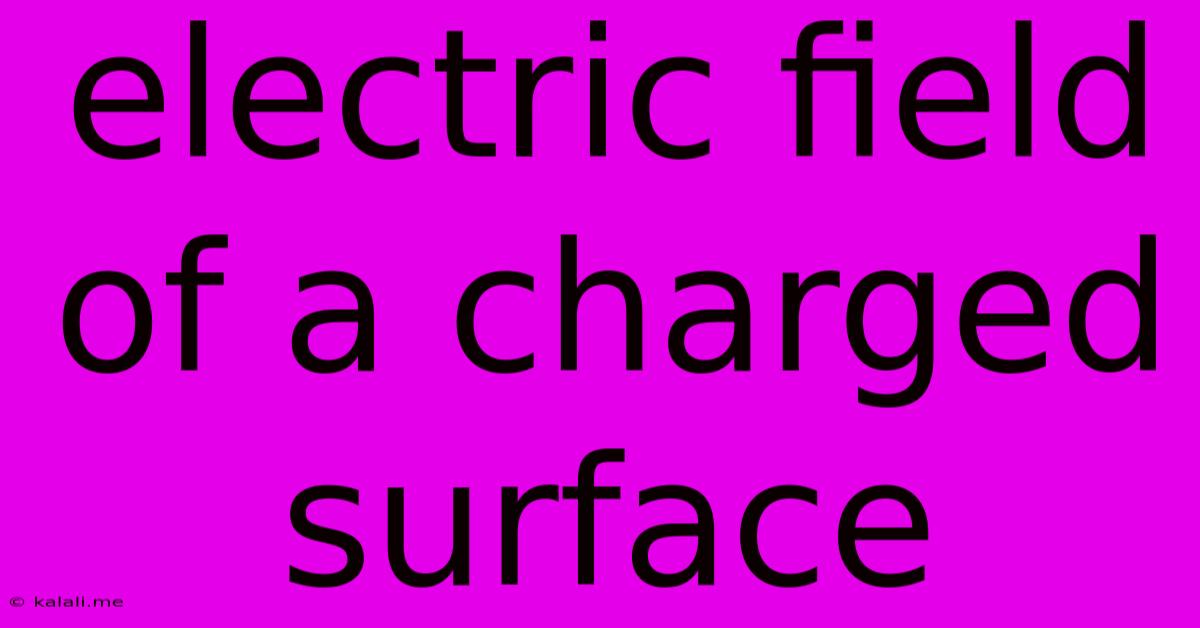Electric Field Of A Charged Surface
Kalali
May 22, 2025 · 4 min read

Table of Contents
Understanding the Electric Field of a Charged Surface
The electric field produced by a charged surface is a fundamental concept in electrostatics with diverse applications in various fields, from understanding capacitor behavior to designing advanced electronic devices. This article delves into the intricacies of calculating and understanding this field, providing a comprehensive overview for both beginners and those seeking a deeper understanding. We will explore different charge distributions and the methods used to determine the electric field strength at various points in space.
What is an Electric Field?
Before diving into charged surfaces, let's briefly review the concept of an electric field. An electric field is a region of space surrounding an electrically charged particle or object where a force would be exerted on another charged particle. This force is described by Coulomb's law, which states that the force between two point charges is directly proportional to the product of their charges and inversely proportional to the square of the distance between them. The electric field strength (E) at a point is defined as the force per unit charge experienced by a small test charge placed at that point.
Electric Field due to Different Charge Distributions
The calculation of the electric field from a charged surface depends heavily on the surface charge density (σ) and the geometry of the surface. The surface charge density is defined as the charge per unit area (Q/A). Let's examine some common scenarios:
1. Infinite Plane Sheet of Charge: This is a simplified, yet insightful, model. For an infinite plane with uniform surface charge density σ, the electric field at any point is given by:
E = σ / (2ε₀)
where ε₀ is the permittivity of free space. The direction of the field is perpendicular to the plane, pointing outwards from a positively charged plane and inwards for a negatively charged plane. Note that the distance from the plane does not affect the field strength – a remarkable characteristic of this idealized scenario.
2. Finite Plane Sheet of Charge: Calculating the electric field for a finite charged plane is significantly more complex. It requires integration techniques, often using Coulomb's law directly and considering the contribution from infinitesimal charge elements on the surface. The solution involves complex mathematics and usually leads to an integral that needs to be solved numerically or through approximation methods.
3. Spherical Surface of Charge: A uniformly charged sphere produces a radially symmetric electric field. Outside the sphere, the field is identical to that of a point charge located at the center of the sphere, with magnitude:
E = kQ/r²
where k is Coulomb's constant, Q is the total charge, and r is the distance from the center. Inside the sphere, if the charge is uniformly distributed, the electric field is zero.
4. Cylindrical Surface of Charge: Similar to the finite plane, calculating the electric field of a cylindrical surface requires integration. The complexity arises from the curvature of the surface and the varying distances to different points on the surface. The method involves integrating over infinitesimal charge elements along the cylindrical surface, applying Coulomb's law, and then resolving the resulting vectors.
Gauss's Law and Charged Surfaces
Gauss's law provides an elegant alternative method for calculating the electric field of symmetric charge distributions. It relates the flux of the electric field through a closed surface to the enclosed charge. For highly symmetric situations like an infinite plane or a sphere, Gauss's law simplifies the calculation significantly, avoiding the need for complex integration. However, it's important to note that Gauss's law is most effective when symmetry is present; for irregularly shaped surfaces, direct integration using Coulomb's law is often necessary.
Applications of Electric Fields from Charged Surfaces
The electric fields produced by charged surfaces are crucial in a multitude of applications, including:
- Capacitors: Capacitors store electrical energy using two conductive surfaces separated by an insulator. The electric field between the plates determines the capacitance.
- Electrostatic Discharge (ESD) Protection: Understanding electric fields is vital in designing protective measures against ESD, which can damage sensitive electronic components.
- Particle Accelerators: Charged surfaces are used to accelerate charged particles in various research applications.
- Inkjet Printers: Charged ink droplets are manipulated by electric fields to create precise patterns on paper.
Understanding the electric field of a charged surface is critical in many scientific and engineering disciplines. While simple cases like an infinite plane can be analyzed using straightforward formulas, more complex shapes require more advanced mathematical techniques. Mastering these concepts is essential for anyone working with electrostatics and its numerous applications.
Latest Posts
Latest Posts
-
Red Wire From Ceiling But Not From Fan
May 23, 2025
-
3 Way Switch To Motion Sensor
May 23, 2025
-
Regular Language Closed Under Cycle Operator Proof
May 23, 2025
-
How To Find Zero Lift Line For A Wing
May 23, 2025
-
Cube Root Of A Square Root
May 23, 2025
Related Post
Thank you for visiting our website which covers about Electric Field Of A Charged Surface . We hope the information provided has been useful to you. Feel free to contact us if you have any questions or need further assistance. See you next time and don't miss to bookmark.